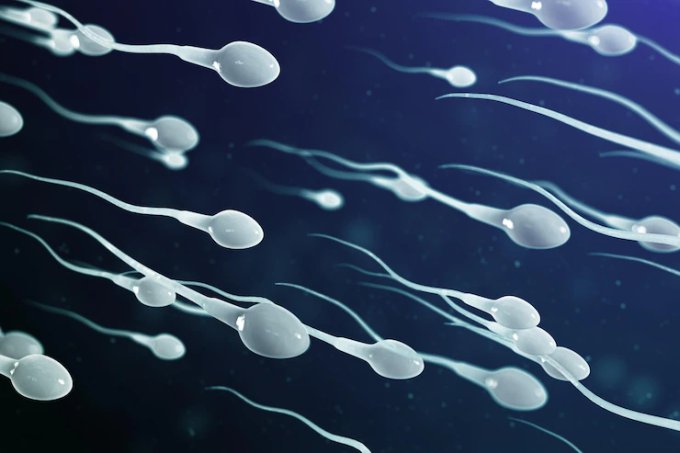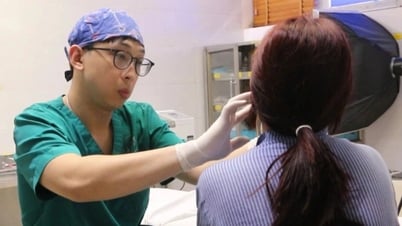Sperm are produced in the male body every day but a full sperm regeneration cycle takes about 64 days.
According to Dr. Ngo Dinh Trieu Vy, Reproductive Support Center, Tam Anh General Hospital, Ho Chi Minh City, spermatogenesis is the entire process of sperm production and functional maturation. This process occurs regularly and continues until the end of life.
The male testicular "factory" produces several million sperm every day, which means about 1,500 sperm are produced every second. So by the end of a full production cycle, a man's body can regenerate up to 8 billion sperm.
Each ml of semen released during ejaculation contains 20-300 million sperm cells. Therefore, the regeneration of such a large number is necessary to ensure an abundant supply of new sperm, serving the conception process well.
A regeneration cycle usually lasts an average of 72 days, including 3 stages. First, spermatogonia divide with a diploid chromosome set and undergo meiosis to form spermatocytes with a haploid chromosome set, capable of carrying genetic data. Next, spermatocytes will enter the differentiation stage to become mature spermatozoa in the testes, especially in the seminiferous tubules. Mature spermatozoa will enter the "sperm competence" stage in the epididymis to gain the ability to swim and move.
Mature sperm have a head containing genetic material and a tail to move and swim easily through the vagina, uterus and fallopian tubes of women to fertilize. After being produced, sperm will move into the epididymis (a tube connected to the testicles to store sperm). The epididymis has the role of storing sperm until ejaculation.
The process of spermatogenesis will continuously fill the epididymis with new sperm. Therefore, the longer a man does not ejaculate, the more sperm will accumulate and the higher the number of sperm in one ejaculation.
The healthier the sperm, the higher the chance of conception. In addition to quantity, sperm quality is assessed by two factors: mobility and morphology.
Motility is the movement of sperm. Sperm motility is measured by the number of sperm that are moving. A man is considered fertile when at least 40% of his sperm are motile. Morphology, or normal sperm shape, should have a long tail and an oval head. A higher number of sperm with a normal shape means a higher chance of conception.

The healthier the sperm, the higher the chance of conception. Photo: Freepik
According to Dr. Ngo Dinh Trieu Vy, men can improve sperm health in many ways.
Exercise regularly : A 2014 study that analyzed 433 semen samples from 231 participants found that men who regularly participated in outdoor activities or weightlifting for about 3.2 hours/week had a 42% higher sperm count than men who did not exercise.
Get enough vitamin C and D : A 2016 study of 200 men found that those who lost weight and supplemented with 1,000 mg of vitamin C daily had an increase in sperm count and motility. Another 2015 study of 102 couples also found that men with normal vitamin D levels in their blood samples had wives with higher pregnancy rates than wives of men with vitamin D deficiency, although there was no significant difference in sperm count or motility.
Get enough Lycopene : A 2014 study found that consuming 4-8 mg of lycopene per day may help increase sperm count and viability, or the number of live sperm in a given semen sample. Lycopene is an antioxidant found in many fruits and vegetables.
Limit or quit smoking : In 2015, a comprehensive review of 33 studies dating back to 1982 found that smoking has a significant effect on semen quality and sperm function, especially in men with normal fertility.
Limit alcohol : Another study of 1,221 men found that the more alcohol they drank, the more likely they were to produce abnormally shaped sperm. The researchers also noted that drinking alcohol is associated with low testosterone levels, which can affect fertility.
Wear loose, cool underwear and clothing : The testicles need to maintain a temperature of 35-37 degrees Celsius, cooler than body temperature. This is the optimal environmental condition for sperm production. Wearing underwear that is too tight, jeans or other tight clothing will press the testicles against the body and increase their temperature, causing sperm to lose their mobility and ability to survive.
Phuong Trinh
Source link


![[Photo] Readers line up to visit the photo exhibition and receive a special publication commemorating the 135th birthday of President Ho Chi Minh at Nhan Dan Newspaper](https://vphoto.vietnam.vn/thumb/1200x675/vietnam/resource/IMAGE/2025/5/17/85b3197fc6bd43e6a9ee4db15101005b)
![[Photo] Nearly 3,000 students moved by stories about soldiers](https://vphoto.vietnam.vn/thumb/1200x675/vietnam/resource/IMAGE/2025/5/17/21da57c8241e42438b423eaa37215e0e)


![[Photo] Prime Minister Pham Minh Chinh chairs meeting on science and technology development](https://vphoto.vietnam.vn/thumb/1200x675/vietnam/resource/IMAGE/2025/5/17/ae80dd74c384439789b12013c738a045)
![[Photo] More than 17,000 candidates participate in the 2025 SPT Competency Assessment Test of Hanoi National University of Education](https://vphoto.vietnam.vn/thumb/1200x675/vietnam/resource/IMAGE/2025/5/17/e538d9a1636c407cbb211b314e6303fd)

























































































Comment (0)